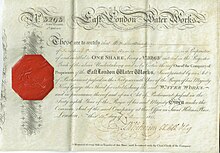
The East London Waterworks Company was one of eight private water companies in London absorbed by the Metropolitan Water Board in 1904.
The company was founded by the East London Waterworks Act 1807 (47 Geo. 3 Sess. 2. c. lxxii).
Under the East London Waterworks Act 1808 (48 Geo. 3. c. viii) the company acquired existing waterworks at Shadwell (dating from 1660) Lea Bridge (pre 1767) and West Ham (1743).
Predecessor companies
Shadwell Waterworks
The Shadwell Waterworks Company commenced operations in 1669, and was incorporated (as the 'Governor and Company of the Water Works and Water Houses in Shadwell') in 1692 by the Shadwell Waterworks Act 1691 (3 Will. & Mar. c. 37 Pr.).
The Shadwell Waterworks were purchased for £50,000 in 1801 by the London Dock Company, using powers granted in the Port of London Improvement Act 1800 (39 & 40 Geo. 3. c. xlvii).
West Ham Waterworks
Between 1743 and 1745, the West Ham Waterworks Company built a waterworks at Saynes Mill in Stratford. The company was incorporated by the West Ham Waterworks Act 1747 (21 Geo. 2. c. 8). This company was also purchased by the London Dock Company, using powers granted by the London Dock Company Act 1807 (47 Geo. 3 Sess. 2. c. v).
In 1785 the West Ham Waterworks Company and the Shadwell Waterworks Company agreed a boundary between their respective areas of supply, so they were not completing.
Hackney Waterworks
The Hackney Water Works Company was established in around 1760 at Lea Bridge Mills. It was acquired from John Killick by the East London Waterworks, who were authorised to extract water at that location by the East London Waterworks Act 1829 (10 Geo. 4. c. cxvii)
Water supply
The water supplied by the company was taken from the Lea, with waterworks on 30 acres (0.12 km2) of land at Old Ford. A ceremonial opening took place in 1809.
In 1829, the source of water was moved further up river to Lea Bridge as a result of pollution caused by population growth. In 1770, the Hackney Cut, had been built across Hackney Marshes to avoid a 2 miles (3.2 km) meander of the natural river course; clean water was now abstracted from the natural channel to a new reservoir at Old Ford.[1] In 1830 the company gained a lease on the existing reservoir at Clapton. This was replaced by a new reservoir at Stamford Hill in 1891.[2]
Supply area
Although the legislation that established the London water companies intended that they would compete for customers, in 1815 the East London company drew up a legal agreement with the New River Company defining a boundary between their areas of supply.
In 1841 the company supplied 36,916 houses.[3] By 1903 this figure had risen to 223,891 houses, with the area of supply having a population of 1,482,156.[4]
In 1845 the limits of supply were described as "all those portions of the Metropolis, and its suburbs, which lie to the east of the city, Shoreditch, the Kingsland Road, and Dalston; extending their mains even across the river Lea into Essex, as far as West Ham."[3]
Contamination
In 1866, during a cholera pandemic outbreak, where 5,973 Londoners perished, the East London Water Company was found guilty of supplying contaminated water taken from River Lea and stored into open reservoirs. Dead eels were found in water pipes, and foul water taken from the reservoirs and pumped into the main supply.[5]
Municipalisation
The Metropolis Water Act 1902 amalgamated the eight private water companies into the Metropolitan Water Board, whose members were chosen by the various local authorities of the metropolitan area.
See also
References
- ^ East London Waterworks Company, Brief history during the Snow era, 1813 - 1858 (UCLA Epidemiology), accessed October 1, 2007
- ^ Hackney: Public services, A History of the County of Middlesex: Volume 10: Hackney (1995), pp. 108-15 (British History Online) accessed October 1, 2007
- ^ a b Joseph Fletcher, Historical and Statistical Account of the present System of Supplying the Metropolis with Water, Journal of the Statistical Society of London, Vol. 8, No. 2. (June, 1845)
- ^ Percy Ashley, The Water, Gas, and Electric Light Supply of London, Annals of the American Academy of Political and Social Science, Vol. 27, Municipal Ownership and Municipal Franchises. (January, 1906), pp. 20-36.
- ^ J. Marriott, Beyond The Tower - A History of East London, 2011. http://yalepress.yale.edu/book.asp?isbn=9780300148800








